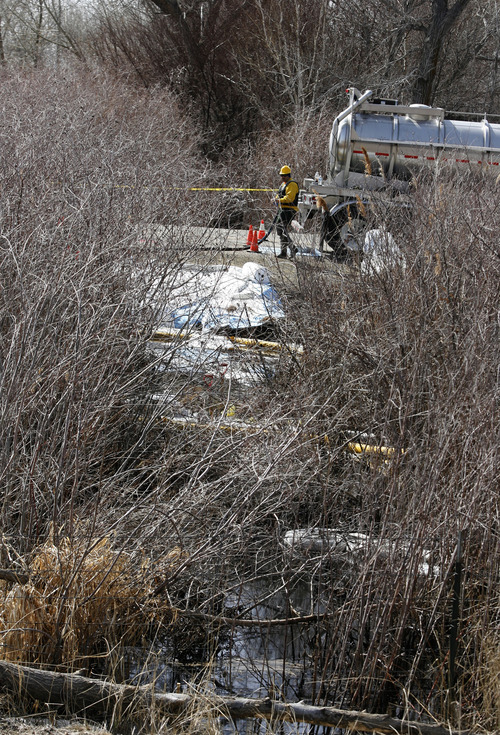This is an archived article that was published on sltrib.com in 2013, and information in the article may be outdated. It is provided only for personal research purposes and may not be reprinted.
Crews continue to clean up the estimated 27,500 gallons of diesel that poured into a beaver-pond complex at Willard Bay State Park from a Chevron pipeline last week.
The initial emergency response to the site near Willard Bay Reservoir has transitioned into a new phase of cleanup that will allow more focus on fish and wildlife impacts, according to a spokesman for the U.S. Environmental Protection Agency, which leads the multi-agency team overseeing the cleanup.
"The initial emergency response phase should begin to transition into a long-term remediation process in the near future," said Joyel Dhieux, EPA on-scene coordinator. "This will shift the focus from spill prevention and recovery into a phase that is focused on long-term wildlife and ecosystem restoration."
The pipeline leak, first reported March 18, has kept the park's North Marina closed for a week while vacuum trucks draw diesel off the water and absorbent pads and booms sop up smaller particles of contamination in hopes of completing the cleanup before the bird migration season heats up in a couple of weeks. Anglers can now access the South Marina to launch their boats.
Federal pipeline-safety officials have tentatively blamed the spill on a lengthwise splint in a pipe seam affecting an area of about 7 acres.
Cleanup workers were able to catch a third beaver in the pond complex of the state park and deliver it to the Wildlife Rehabilitation Center of Northern Utah on Thursday to join two others delivered to the center two days earlier.
DaLyn Erickson, executive director of the Ogden facility, says things are looking up for all three beavers, which were exposed to the diesel.
"We have gone from cautiously optimistic to optimistic," Erickson said. "They are not out of the woods yet, but we are feeling better about their prognosis."
Surprisingly, the beaver brought in last, on Thursday, seems to be in the best condition. Blood samples from the other two have shown some impacts, but nothing Erickson is very concerned about. One of the animals, the beaver most saturated with the diesel, has some gastrointestinal and urinary issues, but is eating well.
Erickson says she is not sure yet when, or if, the animals might be able to be released back into the wild, but it is likely they will not end up back at Willard Bay.
State fisheries officials have been watching the spill area carefully and report no significant losses as of yet.
There have been no dead fish spotted floating in Willard Bay reservoir, a popular walleye, wiper (hybrid cross between a white bass and a striped bass) and channel catfish, but biologists have found three non-native species of fish in the beaver pond complex that slowed the diesel fuel from reaching the reservoir.
John Whitehead, assistant director of the Utah Division of Water Quality, said test results are being quality checked before being released, but Willard Reservoir appears to have been spared from contamination.
Paul Thompson, regional aquatics manager for the DWR, said one brook trout was found dead and another that seemed "stressed" was spotted. A population of small stickleback fish, likely released into the reservoir during transplant of forage fish decades ago, also seemed stressed. Carp spotted in the pond did not seem impacted by the spill.
"We will take another walk through the beaver complex on Wednesday to see if there are any other species we haven't documented yet," Thompson said.
Whitehead noted that the cleanup team gets an update on the rescued beavers and workers take pains to tread lightly around the lodge that helped block the fuel where the beavers were discovered.
"The beavers and their habitat certainly haven't been neglected," he said. "It's been a top priority."
Twitter: @judyfutah







